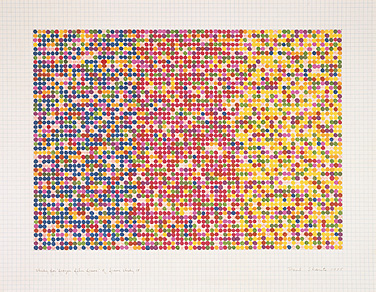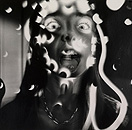News
UB featured prominently in exhibition

Paul Sharits. Study for Frozen Film Frame of “Frame Study 15,” 1975. Ink on graph paper. Collection of the Albright-Knox Art Gallery.
-
 Print
Print -
 Comments
Comments
-

Charles Clough, Eyes 2, 1975. Enamel and gelatin silver prints on cardboard. Collection of George and Sally Hezel.

Ellen Carey, Light Portrait, 1976. Gelatin silver print. Collection of the Albright Knox Art Gallery.
“Wish You Were Here: The Buffalo Avant-garde in the 1970s,” an exhibition opening next week at the Albright-Knox Art Gallery, examines the collaborative, cross-cultural artistic communities that flourished in Buffalo during the 1970s and placed the city at the forefront of the development of the postmodern American avant-garde.
UB was right in the thick of that “creative ecology.”
“Wish You Were Here,” organized by curator Heather Pesanti, will open March 30 and run through July 8.
In conjunction with the exhibition, the UB Department of Visual Studies will co-sponsor with the Albright-Knox a free “Wish You Were Here” symposium April 14-15 that will explore the various artistic, historical, social, cultural and political topics relating to the Buffalo avant-garde of the 1970s. Visit the Albright-Knox website for details.
The Albright-Knox exhibition will examine the venues and organizations that helped define the period, among them the Albright-Knox Art Gallery, Artpark, UB’s Center for Media Study and the independent Media Study/Buffalo, UB’s English department and synchronous grassroots poetry movement, the Center for Exploratory and Perceptual Arts (CEPA), Hallwalls Contemporary Arts Center, the Buffalo Philharmonic Orchestra (BPO) and UB’s Center for the Creative and Performing Arts.
It will display more than 300 objects in a broad array of media and material that illuminate a period of intense creativity. Among works featured are those by Vito Acconci, Ant Farm; Diane Bertolo, John Cage, Ellen Carey, Nancy Dwyer, Catherine Jansen, Sol LeWitt, Robert Longo, Cindy Sherman, Charles Simonds, Bill Viola, Hannah Wilke, Charles Clough, whose work also will be exhibited, beginning March 31, in the UB Art Gallery in the Center for the Arts, and many others.
UB is well-represented, with works by current and former faculty members Tony Conrad (media study), Robert Creeley (English), Morton Feldman (music), Hollis Frampton (media study), Paul Sharits (media study) and Steina and Woody Vasulka (media study).
“Wish You Were Here” also will include many special installations, some of which are first-time, historical recreations of seminal works created in Buffalo during the 1970s that have not been seen since then.
Among these are a multimedia installation by groundbreaking minimalist musician, filmmaker, videographer and UB faculty member Tony Conrad that originally was installed at Hallwalls in 1979 and has been reinterpreted by Conrad for this exhibition, and a seminal filmic “locational” installation by the late UB filmmaker Paul Sharits called “Dream Displacement,” which premiered at the Albright-Knox in 1976. It was preserved through Anthology Film Archives, New York, and will be reinstalled for this exhibition.
A number of experimental initiatives throughout Buffalo, including many at UB, contributed to the avant-garde spirit of the city during the 1970s.
At the Albright-Knox Art Gallery, Director Robert T. Buck Jr. hired visionary curator Linda Cathcart to be the museum’s connection to new and emerging arts practices, and she was charged with exhibiting the newest and the latest in the field. Her first exhibition featured the work of Bruce Nauman, as well as that of UB faculty member Paul Sharits, Gilbert & George, Rafael Ferrer, Ed Ruscha and many others.
Nearby, Hallwalls—with its combination of living and studio spaces—rapidly was becoming a center of grassroots artist circulation. In its first year, Hallwalls exhibited the work of, or brought to town, many artists at the cutting edge, including Vito Acconci, Chris Burden, Dan Graham, Robert Irwin, Lucy Lippard and Barbara Rose.
Concurrently, CEPA, another artist-run organization, showcased photography as an experimental medium, providing another alternative space for artists to exhibit new work.
Meanwhile, the UB Department of English had become a literary hotbed under the leadership of Al Cook, who embraced an open-minded view of professorships and brought Robert Creeley, Leslie Fiedler, John Barth and other luminaries to teach in permanent faculty positions.
When Gerald O’Grady was invited to join the English faculty, he was encouraged to teach whatever interested him; he subsequently created the Center for Media Study (now Department of Media Study) at the university, teaching both the theory and practice of film and video at a time when few universities in the world were doing so.
O’Grady also founded Media Study/Buffalo downtown as an independently funded organization featuring experimental film and video artists and installations.
In music, Lukas Foss came to Buffalo in the 1960s as director of the Buffalo Philharmonic Orchestra, where he routinely added premieres of radical, untested music to the orchestra’s repertoire.
Foss and Allen Sapp founded the Center for Creative and Performing Arts at UB and brought to Buffalo exciting musicians, composers and performers. These “Creative Associates” helped to define the university as a center for the composition and performance of contemporary experimental classical music
Just north of Buffalo, Artpark was flourishing. Dedicated to the memory of land artist Robert Smithson, Artpark was conceived as an outdoor festival spanning the broadest array of arts and featuring artist residencies, including those by Alice Aycock, Nancy Holt, Mary Miss, John Pfahl, Journeyman Press, Charles Simonds and other avant-garde artists.
“Wish You Were Here” will be accompanied by a comprehensive, full-color, catalogue. In addition to an extended essay by curator Pesanti, the publication will include contributions by numerous experts, including several affiliated with UB: Gerald O’Grady, writing about UB’s media study department; Sandra Q. Firmin, curator, UB Art Gallery, writing about Artpark; Bruce Jackson, SUNY Distinguished Professor and James Agee Professor of American Culture, writing about the UB English department; and Renée Levine-Packer, former administrator of UB’s Center for Creative and Performing Arts, writing about the Creative Associates.

Reader Comments